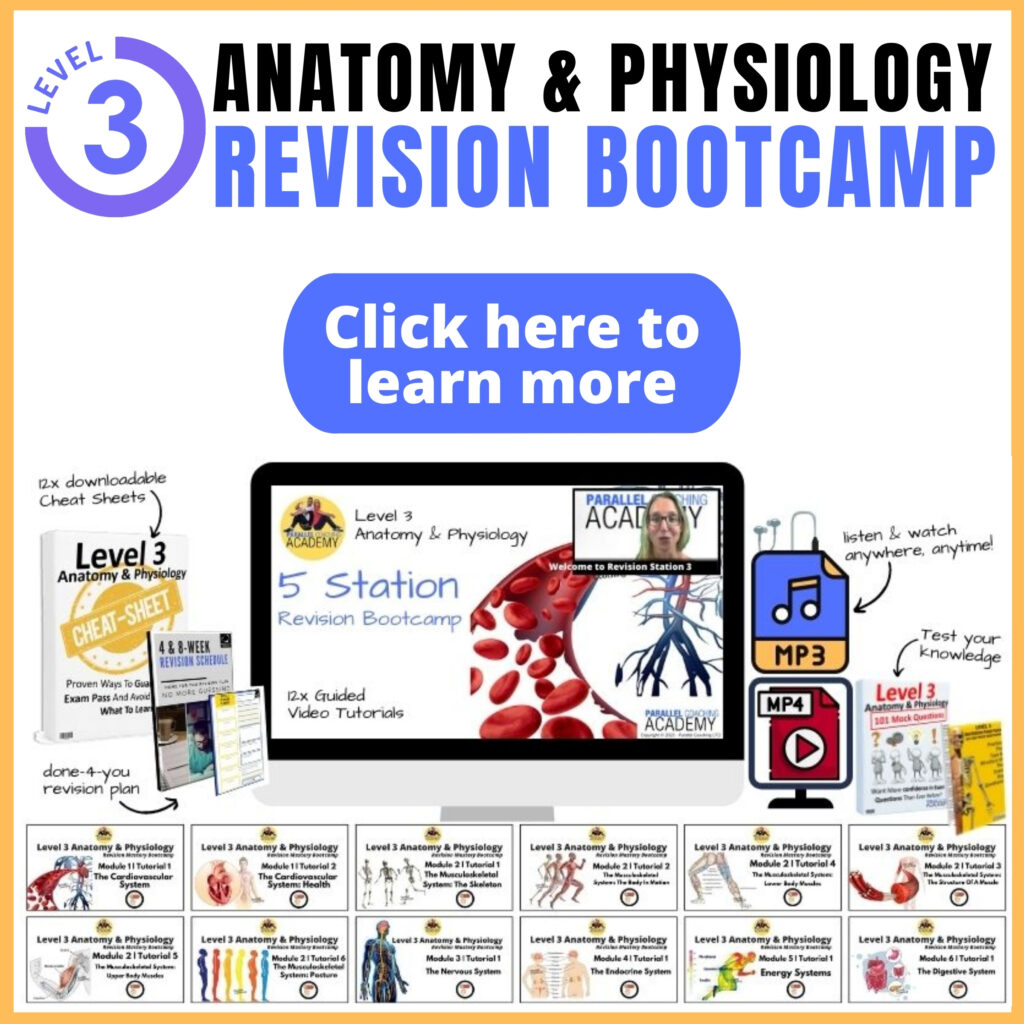You need to know the three anatomical planes of movement as part of your Level 2 and Level 3 anatomy and physiology exams, and it is by far the area of anatomy that learners find the hardest to understand…
I hear time and time again from learners:
“I just don’t understand the three anatomical planes of movement”
This topic can pretty much be guaranteed to appear in anatomy exams at level 2 and level 3. So, I’m going to teach you everything you need to know about all three planes of movement.
In this blog, you’ll find knowledge bombs, images, bullet points, a quiz, and even a short video to help you understand the planes of movement.
What are the three anatomical planes of movement?
Watch this 11-minute video to understand the foundations of Planes of Movement for your exam… This is taken from our Level 3 Anatomy and Physiology Revision Mastery Bootcamp , which has since been updated to a new format making it even easier to learn.
Anatomical Planes of Movement
Anatomical plans are super relevant for both your anatomy and physiology exam, but also for your PT practical and when working with clients post-course.
Once you truly understand these 3 anatomical planes of movement your overall gym programming goes to the next level.

Once you now the 3 anatomical planes, you can easily analyze your clients daily movements and sporting movements so you can plan a specific progression for towards your client’s goal.
See, most people live life using just one plane a time. However, life requires us to move across all three planes constantly.
For example, think about the simple move of getting into a car seat or moving around the office?
You cross all three planes all the time.
Typically in the gym, we spend most of our time training in one plane of movement. for example, a bicep curl is just within the sagittal plane and a squat is also sagittal and running…. in fact we spend a lot of time training sagittally.
If we do not train across all three planes, we increase the risk of injury even when completing basic tasks! I’m sure you know someone that has injured their back when getting the washing out the washing machine for example.
As a personal trainer, knowing these 3 anatomical planes of movements stands you in good stead to support your client’s movements patterns and work smart towards their training goals.
Movement can be divided into three planes…
I’m sure you know that by now…
Planes are imaginary flat surfaces, along which movement takes place. Planes of Motion are kinda like a dimension that you move in.
Plane of movement 1: The sagittal plane
The sagittal plane divides the body into left and right.
Movements that occur in the sagittal plane are flexion, extension, and hyper-extension.
This includes exercises such as biceps curl, leg press of abdominal crunches.
Plane of movement 2: The frontal plane
The frontal plane divides our body into front and back. The anatomical term for the front portion is anterior and the back portion is posterior.
Movements that occur in the frontal plane are adduction and abduction.
This includes exercises such as ‘jumping jacks’ or dumbbell lateral raises.
Understand Frontal Planes movements in detail with this 2-minute video 🙂
Plane of movement 3: The transverse plane
The transverse plane runs through the body at waist level parallel to the ground and separates the body into top and bottom.
Rotational movement occurs within this plane. This includes exercises such as trunk rotations or head rotations.
Horizontal flexion/ extension also occurs in the transverse plane, for example when performing lying dumbbell flys.
Anatomical Planes of Movement Mock Questions
Test your knowledge by answering these three mock questions: answers are at the bottom of the blog.
Q1: Which of the following exercises are performed in the sagittal plane
A. Bicep Curl
B. Rusian Twist
C. Lateral Raise
D. Lat Pull Down
Q2: Which of the following is NOT an anatomical plane of movement?
A. Frontal
B. Transverse
C. Medial
D. Sagittal
Q3: Which joint action can occur in the transverse plane?
A. Flexion
B. Lateral Flexion
C. Adduction
D. Internal Rotation
ANSWERS
Q1 = A
Q2 = C
Q3 = D
If you want more mock questions like this, then you can download more Free Mock Questions: DOWNLOAD NOW
Need More Help with your Level 3 Anatomy Revision?
For Trainee FITPROS Taking Their L3 Anatomy & Physiology Exam.
Learn, Revise & Pass Your Level 3 Anatomy & Physiology Exam In Under 10-hours
(Without Having To Spend Hours Revising Or Feeling Overwhelmed)
If you want to get your revision structured, learn everything you need to know and feel confident on exam day, then click the link below:

Dedicated to More
Hayley “All 3 Planes” Bergman
Parallel Coaching
P.S. You can also find us on the following platforms:
Instagram: Follow Now
Facebook: Like Our Page
Twitter: Tweet Us
YouTube: Subscribe Here
More Planes Blogs: HERE

